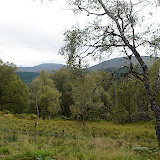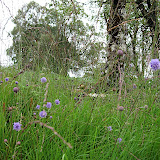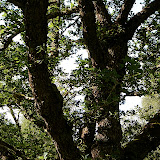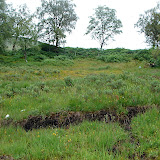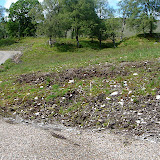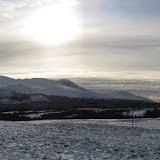This is a useful website: http://www.trafficscotland.org/lev/index.aspx
For instance, the cameras on the A87 are just over the hill to the north of us; and the A9 cameras at Drumochter give an indication of how things are there. Though perhaps one should not rely on them too much, as the BBC News website refers to chaos on the A9 at some unspecified place in the Highlands.
Still, it is quite reassuring to look at the pictures and see that the roads are not totally covered with snow.
Thursday, December 31, 2009
The Refreshment of Spirit Afforded by a Truly Competent Tradesman
Joy unconfined, Donald is here, with his little spade and a heat gun. He has made an excavation at the leaking pipe place; and found that it is not frozen, but burst probably because some sensor in the Nibe had failed to tell the pump to stop pushing, when a blockage of ice next to the Nibe prevented any water getting through. You may well say why have the Nibe virtually outdoors. Well, it is just one of those things that one does. The little gun is now unfreezing the pipe in the cupboard.
He said we would be lucky to get away with no bursts indoors; and lo he was right. A line of drips has appeared just over the dining table, from a burst behind the plasterboard on the north side of the landing. So now we have a new hatch there, rather as Roy has always wanted. I think the tally of leaks is five: the popped pipe to the washing machine; the pipe from the well; the one upstairs; another one in a pipe feeding the top of the Nibe; and, finally, one in the utility room, in the wall above the washing machine, where the leaking water started running into the electric socket and tripping the main fuse. There will be another hatch in the utility room wall, perhaps with a useful cupboard in front of it. We are keeping the pieces of burst pipe as a reminder of the Awesome Power of Ice.
At the end of a long day, all that seems to be left to do is to replace the pressure sensor on the tank, as it seems to have been knocked out by the frost. Donald will be able to get a new one next week. In the mean time, Roy has been shown how to get 100 litres of water at a time by turning on the pump and watching for the pressure to get to the critical level. A great improvement on no water at all; and I shall be able to wash my hair.
Some good news, though: the sitting room and living room floors are positively cosy and there is perceptible heat in the study, the hall and the shower room floors. I am walking around barefoot with No Ill Effects.
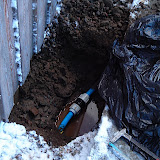 |
| Waterworks |
At the end of a long day, all that seems to be left to do is to replace the pressure sensor on the tank, as it seems to have been knocked out by the frost. Donald will be able to get a new one next week. In the mean time, Roy has been shown how to get 100 litres of water at a time by turning on the pump and watching for the pressure to get to the critical level. A great improvement on no water at all; and I shall be able to wash my hair.
Some good news, though: the sitting room and living room floors are positively cosy and there is perceptible heat in the study, the hall and the shower room floors. I am walking around barefoot with No Ill Effects.
Tuesday, December 29, 2009
Chains
We went up the drive to put on the chains and I took some pictures too, though not of the chains I see. We thought it would make sense to put them on before their need becomes urgent.
We were pleased to see that Klarg is having a warmish time underground, presumably working away, not that we have been able to send him anything recently. Oh, sudden thought: we must OBVIOUSLY put a chapel of relief somewhere over his roof, with direct access, for situations such as the one we now find ourselves in. I wonder if there is an optional extra of this sort already available, or if we will have to get it retro-designed.
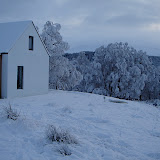 |
| More snow |
Monday, December 28, 2009
Highland Housekeeping - midwinter
Well, we are perfectly at ease boiling up snow for water and washing ourselves and our dishes in a teaspoonful; but this is a new challenge successfully completed - being in the middle of of putting together a dish of spoonbread when the electricity goes off, and IMMEDIATELY coming up with the solution: "No problem - I can fry it in spoonfuls."
Also Remembering Where We Left The Torches.
The electricity came on again after two minutes.
Also Remembering Where We Left The Torches.
The electricity came on again after two minutes.
More Pictures of Snow
I have just been out in the snow to take more pictures. I didn't go far, as I was alone and I have been rather uncomfortably aware in recent months of reports of people going out for little walks and then being found as corpses some time later.
I found lots of deep snow, well up to my boot tops. It is sticking very tenaciously to the branches of the trees. It is the sort of dry snow that doesn't make snowballs, so we would have difficulty running the Eurostar trains here; and I am thinking of opening a ski slope.
In one place, the deer had clearly been scraping the snow away to get at something to eat, which seems to have been dead bracken.
In this sort of place, in this sort of weather, I recommend reading Michelle Paver's books about life in the Stone Age. I recently read a review of her books which said that they were a good thing for modern children to read, as they show how it is possible to exist without pretty much any of the things we would regard as essential.
Photos will follow, when Livy has stopped cleaning her stairs.
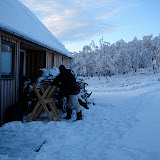 |
| More snow at the Wood |
I found lots of deep snow, well up to my boot tops. It is sticking very tenaciously to the branches of the trees. It is the sort of dry snow that doesn't make snowballs, so we would have difficulty running the Eurostar trains here; and I am thinking of opening a ski slope.
In one place, the deer had clearly been scraping the snow away to get at something to eat, which seems to have been dead bracken.
In this sort of place, in this sort of weather, I recommend reading Michelle Paver's books about life in the Stone Age. I recently read a review of her books which said that they were a good thing for modern children to read, as they show how it is possible to exist without pretty much any of the things we would regard as essential.
Photos will follow, when Livy has stopped cleaning her stairs.
Interesting Times, in the Chinese sense
We are at the Wood for New Year. The roads were pretty good, though there had obviously been a lot of snow and the fir trees in Perthshire, in particular, were looking very spectacularly snowy. The glen road was not bad, either, though not quite so amazingly clear as the time I came with Livy. The only difficulty was when we courteously went into passing places for other people to pass, and then had to dig ourselves out of them. Moral: always carry a sturdy shovel when travelling in the Highlands in winter.
We did not even consider driving down our track, and rather regretted not having taken the sledge out of the attic and brought it, as everything has had to be carried down to the house on foot, of course.
Here, we found that there had been a power cut and, more importantly, all the taps, and presumably all the pipes, are frozen. Since then (nearly 24 hours on) the electricity has been off again, and the pipes are still frozen. One of the pipes to the washing machine has sprung off its connection; but, so far, the only other freeze-related water-supply occurrence has been the discovery that there is a leak in the pipe from the well, fortunately outside the house, and controlled by turning off the pump.
Donald is off on holiday until Thursday but is aware of our problems and will be with us then. How he will deal with the leaking water supply is His Problem, and we just hope we will not have to throw too much money at it. So until then we are reminding ourselves how much worse it could be, hoping that we don't get a practical demonstration of exactly how much worse, and hunkering down. (Literally, when it comes to those functions for which having a working water system is so useful.) (Let's just say that there will be part of Roy's projected grass plot that will be quite nicely supplied with nitrogenous and other solid fertilising matter.) We are reasonably well prepared for this sort of thing, mentally, because of Another Place; but the new experience is melting snow for water. (I have a feeling they did that in one of the Olivia Fitzroy books, perhaps The House in the Hills.)
The trees look perfectly lovely and the mounds of snow are of the perfect, powdery, just like icing sugar variety; so in spite of the cold and the difficulties, we are enjoying the beauty here.
We did not even consider driving down our track, and rather regretted not having taken the sledge out of the attic and brought it, as everything has had to be carried down to the house on foot, of course.
Here, we found that there had been a power cut and, more importantly, all the taps, and presumably all the pipes, are frozen. Since then (nearly 24 hours on) the electricity has been off again, and the pipes are still frozen. One of the pipes to the washing machine has sprung off its connection; but, so far, the only other freeze-related water-supply occurrence has been the discovery that there is a leak in the pipe from the well, fortunately outside the house, and controlled by turning off the pump.
Donald is off on holiday until Thursday but is aware of our problems and will be with us then. How he will deal with the leaking water supply is His Problem, and we just hope we will not have to throw too much money at it. So until then we are reminding ourselves how much worse it could be, hoping that we don't get a practical demonstration of exactly how much worse, and hunkering down. (Literally, when it comes to those functions for which having a working water system is so useful.) (Let's just say that there will be part of Roy's projected grass plot that will be quite nicely supplied with nitrogenous and other solid fertilising matter.) We are reasonably well prepared for this sort of thing, mentally, because of Another Place; but the new experience is melting snow for water. (I have a feeling they did that in one of the Olivia Fitzroy books, perhaps The House in the Hills.)
 |
| At the Wood in snow |
The trees look perfectly lovely and the mounds of snow are of the perfect, powdery, just like icing sugar variety; so in spite of the cold and the difficulties, we are enjoying the beauty here.
Wednesday, December 09, 2009
Geology
Our friend Richard the geologist has not been able to visit yet. But the new British Geological Survey website is full of information. Go to http://www.bgs.ac.uk/opengeoscience/digMap50viewer/ and then navigate eastwards from Loch Hourn for the Wood. If you use sufficient magnification Loch Quoich and Loch Poulary are labelled. The bedrock is Upper Garry Psammite Formation and the superficial layer is mostly hummocky (moundy) glacial deposits - diamicton, sand and gravel. Our own superficial peat bogs are also marked.
Psammite is sandstone. (The psammead is a sand fairy.) Who told us we were on granite?
Perhaps we should be excavating our horticultural grit onsite, just as we got our road-making material there.
Psammite is sandstone. (The psammead is a sand fairy.) Who told us we were on granite?
Perhaps we should be excavating our horticultural grit onsite, just as we got our road-making material there.
Monday, November 16, 2009
More gardening works
The wood is beginning to shut down for the winter. The bracken is already looking dusty rather than vivid, except when the sun is shining directly onto it. There are very few leaves left on anything other than a few birches. Contrary to what we read somewhere recently, the oaks actually lost their leaves before the birches. I hope this doesn’t mean something bad about their health
I am full of foreboding about the plants we got from Abriachan and put in with so much hope. The meconopses lasted for quite a while looking fresh; but they are now chewed. Some things seem to have completely disappeared; and although one expects this of herbaceous plants in the autumn, one does not expect it of azaleas. The olearia macrodonta has despairingly dropped all its leaves, which the bush in the St Andrews garden will hold until spring. (I hope you understand my subordinate clause.) But on the bright side, the sempervivums and the lavender planted in the scree appear to be untouched, although there is a clear deer path running along the top of the bank, just above them..
I am not sure whether it is deer or the condition of the soil that has done these things. The deer are easy to blame, and are clearly responsible for some of the havoc; but peat is a drowning medium and I now think I ought to have put more grit in with the plants. They may well have simply no oxygen around their roots.
So I now have two projects: to get a few tonnes of grit from the quarry and to fence the parts I am going to garden. This is not a large area: around Klarg; just beside the gravel outside the kitchen windows; and to the east behind where the shed will be.
Until our visit by the local fencer we were considering whether to electrify at least the bit near the house, and perhaps some small areas in the wood, for regeneration as suggested by Graham Tuley, as the wires are less visible than proper deer fences and much cheaper to erect. Apparently, electric fences can keep out red deer, unless they are galloping, in which case they simply run through the wires hardly noticing the shock. Roe deer, on the other hand, having smaller feet, do not earth the electricity so well; so the fences are not so good against them. We have mostly red deer, so we are willing to try electricity. But we have now been told by the fencer, who admits he doesn’t do the electric stuff, that it tends to short out with damp vegetation in these damp parts, and needs constant patrolling.
We are still thinking about the idea of herding the deer away from parts that are interesting to us, whilst allowing them through the wood so that they can shelter there in bad weather. One thing we are trying is discouraging them with roses. We have brought some rosa rugosa suckers that we dug out of our front garden, which they were invading from next door, last weekend. They have been planted in an artful snaky line roughly parallel to the drive, near the top end, across a deer track which I think is the way, or one of the ways, the deer get onto the drive. I have no idea if the roses will survive the move or even if they will survive experimental browsing, or whether the deer will simply sneer at them. They are pretty prickly, so eating may not be their fate. The fencer thinks nothing short of a full-blown deer fence will keep deer out, once they have a taste for being in.
He came at 8.30 on Saturday. There was a certain amount of shaking of the head about the terrain and the fact that what we want is a renovation job, essentially, with not much new work. We are agreed that we should have deer fence strainers put in wherever there is work to be done, even in ordinary stock fences. We need a proper pair of strainers at the new gap in the middle fence; a replacement strainer at the top fence where the middle fence joins it, and a good solid main entrance gate and strainers there to hoick up the twiddly collapsed wires that Ursula found so pretty in the air frost last New Year.
We may be able to afford a new fence running transversely just down the hill to the south of the house, and then turning and going back up to the road. This will slightly spoil ma’s favourite view; but it will help with the introduction of Alien Garden Plants from Abriachan into quite a wide area. Graham Tuley and the chaps at Scottish Native Woodlands will disapprove; but I will undertake not to introduce rhododendron ponticum, Japanese knotweed or Himalayan balsam.
There is not even the slightest chance that any serious fence person would get to grips with the idea of small exclusion areas to help little bits of regeneration. So will all members of the family and those who would like the odd holiday here now please start exercising their biceps. The priority is to do something to protect the knee high oaks.
As for grit: we went to Alexander Ross’s quarry at Daviot on Friday - quite a long drive along the road to the south and east of Loch Ness, almost as far as the A9. The quarry is staffed by lovely men with beautiful Highland accents but few words. One says, “Hello, I am the person who has been bothering you daily about horticultural grit. Can we have some?” And they smile sweetly and say not a word for several minutes until, not at all sure of the conversational rules, one ventures an enquiry about where one might find it. We were eventually directed, in an admittedly friendly silence, to a fairly small heap of 6mm grit beneath one of the pipes on legs amidst the muddy puddles in the middle of the quarry, with legions of lorry behemoths crashing past us through the puddles, carrying the really serious stuff off to seriously manly engineering operations; and were told we could take whatever the car could carry. Thank goodness it was a bashed up old Volvo and not something effete. It was assumed that we would not manage as much as a tonne, and we were charged the standard minimum price for anything less than that, which is laughably cheap. We felt very pleased that we had enough understanding of how these things work to have taken our own shovel and bulkbag.
With the grit, I have planted some narcissus lobularis up near where the gate will be. Yes, I know daffs are naff when planted in groups by gates; but there you are. It took me an hour to plant sixty of them before it got too dark to be sure if they were upside down or not. The rest were done the next morning in the rain. I have one of those natty bulb planters, with a nifty little lever thing that makes the circular cutter wider in order to let the plug of earth drop out, if the earth in question is not too sticky and full of roots and things. So it is really a machine, as Roy says. It works very well in places where the existence of grass shows that there is at least some earth; but I struggled foolishly in places that are essentially pure moraine and builders’ rubble. Still, I got it down to a routine: screw down hard on the planter to remove the plug; put in a little heap of grit, a bit of chicken shit and the bulb; and replace the plug.
The other project was planting 100 gladiolus byzantinus. Christopher Lloyd says they go well in rough grass but I think he had something different in mind from what we have here, so I planted them on the scree slope on the north front. This proves, in fact, to be an ingenious heap of rather large stones clothed variously in peat and scree and with, in places, a worrying core of what looks as if it might be unused building sand and the swillings from a concrete mixer. So I spent an hour scrambling around a forty five degree slope with a spade, hauling out boulders and digging out some of the rushes that had been imported with the peat. I got a couple of dozen bulbs planted in the afternoon before the rain became too insistent and the rest done the following morning. I wonder if they will come up, or if I should have paid more attention to the advice on one website which is that they should be lifted for the winter.
The other thing that happened was that Roy started digging over the area to the south and east of the decking, at the top of the slope there, that will become a sitting out lawn. I have only just been told that this is his plan; but I concur. Quite a lot more digging to do, and the incorporation of lots of grit and humus.
I am full of foreboding about the plants we got from Abriachan and put in with so much hope. The meconopses lasted for quite a while looking fresh; but they are now chewed. Some things seem to have completely disappeared; and although one expects this of herbaceous plants in the autumn, one does not expect it of azaleas. The olearia macrodonta has despairingly dropped all its leaves, which the bush in the St Andrews garden will hold until spring. (I hope you understand my subordinate clause.) But on the bright side, the sempervivums and the lavender planted in the scree appear to be untouched, although there is a clear deer path running along the top of the bank, just above them..
I am not sure whether it is deer or the condition of the soil that has done these things. The deer are easy to blame, and are clearly responsible for some of the havoc; but peat is a drowning medium and I now think I ought to have put more grit in with the plants. They may well have simply no oxygen around their roots.
So I now have two projects: to get a few tonnes of grit from the quarry and to fence the parts I am going to garden. This is not a large area: around Klarg; just beside the gravel outside the kitchen windows; and to the east behind where the shed will be.
Until our visit by the local fencer we were considering whether to electrify at least the bit near the house, and perhaps some small areas in the wood, for regeneration as suggested by Graham Tuley, as the wires are less visible than proper deer fences and much cheaper to erect. Apparently, electric fences can keep out red deer, unless they are galloping, in which case they simply run through the wires hardly noticing the shock. Roe deer, on the other hand, having smaller feet, do not earth the electricity so well; so the fences are not so good against them. We have mostly red deer, so we are willing to try electricity. But we have now been told by the fencer, who admits he doesn’t do the electric stuff, that it tends to short out with damp vegetation in these damp parts, and needs constant patrolling.
We are still thinking about the idea of herding the deer away from parts that are interesting to us, whilst allowing them through the wood so that they can shelter there in bad weather. One thing we are trying is discouraging them with roses. We have brought some rosa rugosa suckers that we dug out of our front garden, which they were invading from next door, last weekend. They have been planted in an artful snaky line roughly parallel to the drive, near the top end, across a deer track which I think is the way, or one of the ways, the deer get onto the drive. I have no idea if the roses will survive the move or even if they will survive experimental browsing, or whether the deer will simply sneer at them. They are pretty prickly, so eating may not be their fate. The fencer thinks nothing short of a full-blown deer fence will keep deer out, once they have a taste for being in.
He came at 8.30 on Saturday. There was a certain amount of shaking of the head about the terrain and the fact that what we want is a renovation job, essentially, with not much new work. We are agreed that we should have deer fence strainers put in wherever there is work to be done, even in ordinary stock fences. We need a proper pair of strainers at the new gap in the middle fence; a replacement strainer at the top fence where the middle fence joins it, and a good solid main entrance gate and strainers there to hoick up the twiddly collapsed wires that Ursula found so pretty in the air frost last New Year.
We may be able to afford a new fence running transversely just down the hill to the south of the house, and then turning and going back up to the road. This will slightly spoil ma’s favourite view; but it will help with the introduction of Alien Garden Plants from Abriachan into quite a wide area. Graham Tuley and the chaps at Scottish Native Woodlands will disapprove; but I will undertake not to introduce rhododendron ponticum, Japanese knotweed or Himalayan balsam.
There is not even the slightest chance that any serious fence person would get to grips with the idea of small exclusion areas to help little bits of regeneration. So will all members of the family and those who would like the odd holiday here now please start exercising their biceps. The priority is to do something to protect the knee high oaks.
As for grit: we went to Alexander Ross’s quarry at Daviot on Friday - quite a long drive along the road to the south and east of Loch Ness, almost as far as the A9. The quarry is staffed by lovely men with beautiful Highland accents but few words. One says, “Hello, I am the person who has been bothering you daily about horticultural grit. Can we have some?” And they smile sweetly and say not a word for several minutes until, not at all sure of the conversational rules, one ventures an enquiry about where one might find it. We were eventually directed, in an admittedly friendly silence, to a fairly small heap of 6mm grit beneath one of the pipes on legs amidst the muddy puddles in the middle of the quarry, with legions of lorry behemoths crashing past us through the puddles, carrying the really serious stuff off to seriously manly engineering operations; and were told we could take whatever the car could carry. Thank goodness it was a bashed up old Volvo and not something effete. It was assumed that we would not manage as much as a tonne, and we were charged the standard minimum price for anything less than that, which is laughably cheap. We felt very pleased that we had enough understanding of how these things work to have taken our own shovel and bulkbag.
With the grit, I have planted some narcissus lobularis up near where the gate will be. Yes, I know daffs are naff when planted in groups by gates; but there you are. It took me an hour to plant sixty of them before it got too dark to be sure if they were upside down or not. The rest were done the next morning in the rain. I have one of those natty bulb planters, with a nifty little lever thing that makes the circular cutter wider in order to let the plug of earth drop out, if the earth in question is not too sticky and full of roots and things. So it is really a machine, as Roy says. It works very well in places where the existence of grass shows that there is at least some earth; but I struggled foolishly in places that are essentially pure moraine and builders’ rubble. Still, I got it down to a routine: screw down hard on the planter to remove the plug; put in a little heap of grit, a bit of chicken shit and the bulb; and replace the plug.
The other project was planting 100 gladiolus byzantinus. Christopher Lloyd says they go well in rough grass but I think he had something different in mind from what we have here, so I planted them on the scree slope on the north front. This proves, in fact, to be an ingenious heap of rather large stones clothed variously in peat and scree and with, in places, a worrying core of what looks as if it might be unused building sand and the swillings from a concrete mixer. So I spent an hour scrambling around a forty five degree slope with a spade, hauling out boulders and digging out some of the rushes that had been imported with the peat. I got a couple of dozen bulbs planted in the afternoon before the rain became too insistent and the rest done the following morning. I wonder if they will come up, or if I should have paid more attention to the advice on one website which is that they should be lifted for the winter.
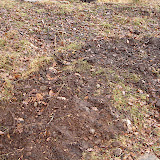 |
| Where the bodies are buried |
Wednesday, October 07, 2009
Thursday, September 24, 2009
On the Dualchas website
Nearly a year now since the house was finished, and the architects have recently posted a few photos and short story about it on their website here. At the moment it is featured on their front page. Apparently the architect likes the monastic aesthetic. Does that mean cold and minimal? No, lacking in knick-knacks apparently.
Sunday, September 20, 2009
Sunday, September 13, 2009
A little gardening
We came to Glengarry via Inverness and the west shore of Loch Ness this time, in order to visit Abriachan Nurseries. Although it is late in the season their garden is still looking enticing, but we concentrated on the things for sale, which are good. There was an amazing geranium growing in a corner, said to be Salome: big pale mauve flowers with bold dark centres. Well, that is as may be. I have put one sold under that name at the edge of the border in front of Klarg. The one flower it is showing at present seems too small and dark. It is probably a bastard offspring.
Also in that border we now have a tall verbena bonariensis. I will have to surround it with bracken fronds in the cold weather. What I hope for ultimately is a tall, light screen of flowers there, if the verbena seeds, which it did for Christopher Lloyd. In front of that is a pale pink fuchsia: White Knight's Blush. Another one for coddling in the winter.
To the right of these, as one looks from the house, there is a very wet shallow groove of ground draining down to Allt na Minion. I walked in it up to my boot tops when it was covered by snow last winter, and had to be rescued by Livy. This will be one of the bog gardens near the house. I have just planted ligularia dentata Britt-Marie Crawford there - good dark leaves and big yellow daisies in due course; and astilboides tabularis, which used to be a rodgersia - large shield-shaped leaves and a plume of white flowers. A gunnera will follow; but there are few available at present because everyone's nursery stocks were knocked out by the cold last winter. I am also going to try growing some candelabra primulas from seed for these damp bits.
The general idea with all of this is that these things will be split and encouraged to spread. In a space this size it is no good just having one of something; you need lots and lots.
There are quite a lot of rushes in the earth put around the house by the builders - a disadvantage arising from the fact that the easiest soil for them to move was from the bog. I dig it up and throw it back into the bog when I come upon it, but it would be rather a major operation to get rid of it all. Yet another thing that visiting work parties will be encouraged to undertake, in the non-midge seasons.
On the scree bank behind the house, where there is already a lavender which I hope may cope with the cold better in very sharp drainage, I have put three sempervivums: Cantabricum Riano, Atlanticum and Blood Tip. They are in almost pure gravel. A whole slope of them would be something. Also in there is a gorgeous saxifrage: fortunei Blackberry and Apple Pie. It has thick shiny leaves about the size of a fifty pence piece, red underneath and green on top.
As I write I am taking a rest from planting, as the midges in the vegetation I am disturbing have been rejoicing in my presence. Still to plant are four more blue poppies (meconopsis sheldonii), which will join the two already at the top of the slope outside the kitchen window (which may be meconopsis betonicifolia); and an azalea luteum. It is a seedling from Abriachan and I am assured it has a good scent. I am not sure what shade of yellow it will be, though. I am going to put it under the birches near the meconopses.
I also have a Miss Jessop rosemary; but she is rather thin and weedy and I think it would be a kindness to keep her in a pot for a bit.
Also in that border we now have a tall verbena bonariensis. I will have to surround it with bracken fronds in the cold weather. What I hope for ultimately is a tall, light screen of flowers there, if the verbena seeds, which it did for Christopher Lloyd. In front of that is a pale pink fuchsia: White Knight's Blush. Another one for coddling in the winter.
To the right of these, as one looks from the house, there is a very wet shallow groove of ground draining down to Allt na Minion. I walked in it up to my boot tops when it was covered by snow last winter, and had to be rescued by Livy. This will be one of the bog gardens near the house. I have just planted ligularia dentata Britt-Marie Crawford there - good dark leaves and big yellow daisies in due course; and astilboides tabularis, which used to be a rodgersia - large shield-shaped leaves and a plume of white flowers. A gunnera will follow; but there are few available at present because everyone's nursery stocks were knocked out by the cold last winter. I am also going to try growing some candelabra primulas from seed for these damp bits.
The general idea with all of this is that these things will be split and encouraged to spread. In a space this size it is no good just having one of something; you need lots and lots.
There are quite a lot of rushes in the earth put around the house by the builders - a disadvantage arising from the fact that the easiest soil for them to move was from the bog. I dig it up and throw it back into the bog when I come upon it, but it would be rather a major operation to get rid of it all. Yet another thing that visiting work parties will be encouraged to undertake, in the non-midge seasons.
On the scree bank behind the house, where there is already a lavender which I hope may cope with the cold better in very sharp drainage, I have put three sempervivums: Cantabricum Riano, Atlanticum and Blood Tip. They are in almost pure gravel. A whole slope of them would be something. Also in there is a gorgeous saxifrage: fortunei Blackberry and Apple Pie. It has thick shiny leaves about the size of a fifty pence piece, red underneath and green on top.
As I write I am taking a rest from planting, as the midges in the vegetation I am disturbing have been rejoicing in my presence. Still to plant are four more blue poppies (meconopsis sheldonii), which will join the two already at the top of the slope outside the kitchen window (which may be meconopsis betonicifolia); and an azalea luteum. It is a seedling from Abriachan and I am assured it has a good scent. I am not sure what shade of yellow it will be, though. I am going to put it under the birches near the meconopses.
I also have a Miss Jessop rosemary; but she is rather thin and weedy and I think it would be a kindness to keep her in a pot for a bit.
Sunday, September 06, 2009
Fungi and a Sofa
On a pretty wet weekend we brought a new sofa to the Wood and were amazed that Livy had constructed the first one alone. The sitting room still doesn't feel full and the sofas are not quite what Dornford Yates described, but it is beginning to look a little like the temple of ease in The House That Berry Built.
We walked around the wood in the rain with our Dutch friends and were enchanted to find more chanterelles, a fair number of boletus and a very few amethyst mushrooms, which look poisonous but mostly aren't.
Some deer sauntered through in the evening, staring at the house to remind us that we are interlopers: a fawn, a hind and a stag. We reminded them not to eat the oaks.
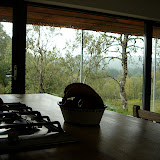 |
| Interiors |
We walked around the wood in the rain with our Dutch friends and were enchanted to find more chanterelles, a fair number of boletus and a very few amethyst mushrooms, which look poisonous but mostly aren't.
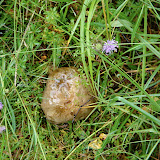 |
| Boletus |
Some deer sauntered through in the evening, staring at the house to remind us that we are interlopers: a fawn, a hind and a stag. We reminded them not to eat the oaks.
Wednesday, August 19, 2009
Compare
Anyone know anything about scat?
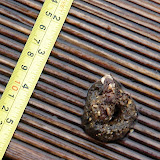 |
| Whose is this |
Sunday, August 16, 2009
Sunday, August 09, 2009
Another Oak
Simon Whipple, visiting with his sons and walking down to the river with Roy, found another knee high oak not far from the other one, on the south slope of the knoll with the dead tree. Seriously, we are going to need a working party for fencing before the winter.
Wednesday, August 05, 2009
Some Ideas
It is pretty clear that, whatever happens, the wood will not just stay as it is now. The question for us is to what extent we intervene in its development. I must say, I am pulled two ways: regenerating the ancient woodland; and dropping choice exotics into it. I wonder if both can be done; and I suppose they can, if one is fairly rigorous about where the dropping is done.
Of course, there are huge temptations: draping clematis or climbing hydrangeas or climbing roses over dead stumps; introducing perennial flowering plants into the woodland: aquilegias, geraniums in the open spaces, astrantia, anemone; putting the odd exotic tree or shrub under the protection of the tree cover: rhododendrons, mainly; and adding exotic trees: liriodendron, swamp cypress, whatever else might survive the long and sometimes harsh, but perhaps less harsh than formerly, winters.
Then there is the temptation of growing things to eat, particularly soft fruit.
Obviously, we have already interfered with the landscape quite a lot. So I don't feel embarrassed at the idea of trying some of the wild daffodil types in a drift on one of the raw banks, or putting an exotic tree or shrub near the house.
I have mentioned bog plants for the places where raw peat has been exposed. I am also wondering what might survive on the dry banks. Miniature wild magenta gladioli, anyone?
Any ideas or opinions out there?
Of course, there are huge temptations: draping clematis or climbing hydrangeas or climbing roses over dead stumps; introducing perennial flowering plants into the woodland: aquilegias, geraniums in the open spaces, astrantia, anemone; putting the odd exotic tree or shrub under the protection of the tree cover: rhododendrons, mainly; and adding exotic trees: liriodendron, swamp cypress, whatever else might survive the long and sometimes harsh, but perhaps less harsh than formerly, winters.
Then there is the temptation of growing things to eat, particularly soft fruit.
Obviously, we have already interfered with the landscape quite a lot. So I don't feel embarrassed at the idea of trying some of the wild daffodil types in a drift on one of the raw banks, or putting an exotic tree or shrub near the house.
I have mentioned bog plants for the places where raw peat has been exposed. I am also wondering what might survive on the dry banks. Miniature wild magenta gladioli, anyone?
Any ideas or opinions out there?
Saturday, August 01, 2009
Monday, July 27, 2009
End of July
Diana and Martin have been here. Diana has removed parts of the stumpery in the bog and so we have been inspired to remove some more. We found a few little blaeberry plants in among the roots; and I have replanted them just outside the study window. I have also planted near there an olearia macrodonta like the one which Janet gave me years ago and which is now huge and very beautiful. The ground beneath the six inches of peat put there by the builders, taken, as I believe I may have said before, from our beautiful peat meadow grrr, is a mixture of orange sand and stones. I have no idea if this is indigenous or builders' waste. I will be interested to see how it operates as a growing medium.
When we took D and M for the usual walk around we had the greatest excitement of finding a huge bush of knee high oak, far down towards the river just to the side of the knoll with the dead tree. The oak is either one sprawling or several not sprawling seedlings, very thoroughly bonsaied by deer. It is eight feet by six feet across and about two feet high. We are amazed that we have not seen it before; but, really, you don't expect to see an oak tree imitating the action of bog myrtle. This is a fencing priority.
Diana and Roy waded across to one of the little islands in the river, as the water was so low, and found three alders there. Rather fairy taleish I feel. Otherwise, we just noticed trees and plants and we sat on rocks in the burn and fantasised about what the Victorians would have done with the ravine. Well, I did.
On Sunday we went to have lunch at the Invergarry Castle Hotel, a very civilised place, because we had to buy some milk. We went for a walk in the grounds which are decayed gentility: lots of big oaks and beeches; the remains of gardens; terraces; gunneras; a whole pond full of arum lilies; and dozens and dozens of oak seedlings. Oh how my trowel finger itched.
I have been taking pictures which will be posted when I can find the intellectual energy. They include some interiors because I have been asked for them. The study is now useable as such; we have moved the sofa to the place where a second one might be put. And the builders have done various things such as fixing the lights which I don't much like over the table (and breaking one of them). The table is really too short for three lights. They have also put up our ingenious American coathooks as yet unavailable here. (Thank you, Max.) The pictures will be there to prove it.
When we took D and M for the usual walk around we had the greatest excitement of finding a huge bush of knee high oak, far down towards the river just to the side of the knoll with the dead tree. The oak is either one sprawling or several not sprawling seedlings, very thoroughly bonsaied by deer. It is eight feet by six feet across and about two feet high. We are amazed that we have not seen it before; but, really, you don't expect to see an oak tree imitating the action of bog myrtle. This is a fencing priority.
Diana and Roy waded across to one of the little islands in the river, as the water was so low, and found three alders there. Rather fairy taleish I feel. Otherwise, we just noticed trees and plants and we sat on rocks in the burn and fantasised about what the Victorians would have done with the ravine. Well, I did.
On Sunday we went to have lunch at the Invergarry Castle Hotel, a very civilised place, because we had to buy some milk. We went for a walk in the grounds which are decayed gentility: lots of big oaks and beeches; the remains of gardens; terraces; gunneras; a whole pond full of arum lilies; and dozens and dozens of oak seedlings. Oh how my trowel finger itched.
I have been taking pictures which will be posted when I can find the intellectual energy. They include some interiors because I have been asked for them. The study is now useable as such; we have moved the sofa to the place where a second one might be put. And the builders have done various things such as fixing the lights which I don't much like over the table (and breaking one of them). The table is really too short for three lights. They have also put up our ingenious American coathooks as yet unavailable here. (Thank you, Max.) The pictures will be there to prove it.
General Notes about what is appearing and what I have planted
Somewhat remiss in the blog-writing recently. Well, not so recently, actually, I see. It is a problem, writing things about a building project when it has virtually ended. All I really have is the report of three months’ worth of wild flowers, which I find interesting, but which may seem dull to some, plus a discussion of trees and one visit to Alasdair about snagging.
Simply in the interests of recording what I may later find has died on me, I note that I have moved some plants from St Andrews and put them at the top of the bank on the south side of the house. So far there are these: the small scented jonquil-like daffodils with slightly twisted petals and a small cup; iris reticulata; erythronium revolutum; narcissus Tete a Tete; iris Katherine Hodgkin, a spectacular spring-flowering miniature; ranunculus aconitifolius plenus, the double white buttercup; some hybrid geranium renardii which have not come out in that lovely grey colour of flower, as they are hybrids; and astrantia. Mike has let me take a root of golden oreganum from Tomdoun. I have also sown some seeds of orleya grandiflora, given me by Gardens Illustrated, and some aquilegia seeds from St Andrews. At the back of the house, on the bank, I have sown some white foxgloves, also from GI. Beside the track, I have cast a weird collection of seeds given by someone. They include cornflower, achillea, some sort of daisy flower, poppies and more aquilegias. In the difficult area in front of Klarg I have buried a thank you letter impregnated with wildflower seeds. Heaven knows what will come up; it felt like an odd thing to do.
The wild flowers already in residence have gone through several waves since I last wrote. Bluebells, wood anemones, wood sorrel and violets gave way to chickweed wintergreen, orchids, tomentil and cinquefoils. (I know the difference, I think.) There is also tick wort, milkwort and those succulent bog flowers that I can’t look up because the wildflower books are elsewhere. Now the bog asphodel has come out in huge swathes, very noticeably behind the house, where it makes a harmonious sweep of yellow surrounded by lines of the different greens of grass, bog myrtle and bracken. Things here seem to go in for monoculture.
The bare banks are greening up reasonably well. Livy has posted some pictures taken several weeks ago which show this; and I am taking some more this weekend. Except in the areas immediately beside the house, where the builders put a layer of peat taken from the meadow, over the brickbats and pieces of wire which I fully expect to find down there one day, the bare earth has had two summers to recover. It is doing particularly well in the place where the original track to the meadow was made and then abandoned. The back of the quarry and the sides of the track are not doing too badly; the banks to the north and south of the house are starting to recover, except the place to the north which is pure scree. The only really slow bit is the long barrow of subsoil up the slope behind the north bank.
Simply in the interests of recording what I may later find has died on me, I note that I have moved some plants from St Andrews and put them at the top of the bank on the south side of the house. So far there are these: the small scented jonquil-like daffodils with slightly twisted petals and a small cup; iris reticulata; erythronium revolutum; narcissus Tete a Tete; iris Katherine Hodgkin, a spectacular spring-flowering miniature; ranunculus aconitifolius plenus, the double white buttercup; some hybrid geranium renardii which have not come out in that lovely grey colour of flower, as they are hybrids; and astrantia. Mike has let me take a root of golden oreganum from Tomdoun. I have also sown some seeds of orleya grandiflora, given me by Gardens Illustrated, and some aquilegia seeds from St Andrews. At the back of the house, on the bank, I have sown some white foxgloves, also from GI. Beside the track, I have cast a weird collection of seeds given by someone. They include cornflower, achillea, some sort of daisy flower, poppies and more aquilegias. In the difficult area in front of Klarg I have buried a thank you letter impregnated with wildflower seeds. Heaven knows what will come up; it felt like an odd thing to do.
The wild flowers already in residence have gone through several waves since I last wrote. Bluebells, wood anemones, wood sorrel and violets gave way to chickweed wintergreen, orchids, tomentil and cinquefoils. (I know the difference, I think.) There is also tick wort, milkwort and those succulent bog flowers that I can’t look up because the wildflower books are elsewhere. Now the bog asphodel has come out in huge swathes, very noticeably behind the house, where it makes a harmonious sweep of yellow surrounded by lines of the different greens of grass, bog myrtle and bracken. Things here seem to go in for monoculture.
The bare banks are greening up reasonably well. Livy has posted some pictures taken several weeks ago which show this; and I am taking some more this weekend. Except in the areas immediately beside the house, where the builders put a layer of peat taken from the meadow, over the brickbats and pieces of wire which I fully expect to find down there one day, the bare earth has had two summers to recover. It is doing particularly well in the place where the original track to the meadow was made and then abandoned. The back of the quarry and the sides of the track are not doing too badly; the banks to the north and south of the house are starting to recover, except the place to the north which is pure scree. The only really slow bit is the long barrow of subsoil up the slope behind the north bank.
Visit from the Tree Man
I have mentioned Graham Tuley before. His second visit deserves a separate posting and I only hope I can remember all his advice. It was a jolly hot day and we walked around looking at trees and discussing management strategies until I was bushed. And then we did it again after lunch.
Graham is a forester of standing, now retired. We don’t know the full extent of his expertise; but we accept it as far beyond what we will ever have the capacity to benefit fully from, if you get my drift. For us, it is the regenerating old woodland aspect that is important.
We made the beginnings of an inventory: pretty much the species that I have mentioned before. What we should be trying to encourage are the oaks and hazels, which are old; and only the hazels seem to be putting out seedlings. Birch doesn’t really need much encouragement, though it would be nice to see some young ones getting beyond bonsai size. We should try to get the right variety of Scots pine to gain or regain a foothold.
There is a lot of erudite stuff about Scots pines which I have somewhat forgotten, taking away from it the memory of the name of a book, which Roy has written down somewhere, and the fact that Scots pines have various varieties (sub-species?) that appear only in very restricted areas. The Knoydart pines at Runival and Barrisdale are completely different from the ones in Glengarry. There is a pocket of very ancient trees indeed just over the hill from the Wood in the direction of Loch Loyn. Apparently, it is important not to interfere with the speciation and geographical speciality, so we must be careful to take seeds for our pines from old trees in Glengarry, and not planted ones.
In general, we should be putting trees where bracken flourishes – no point in even thinking of doing anything in the bogs. I am reasonably content with that, though I shall probably try the odd willow in the bog – acceptable as it is a native tree, and taxodium, to see if it grows knees. This is markedly not acceptable, or perhaps just marginally so if placed near the house. I am not to plant a Wellintonia. (Mutinous muttering – but I might just conceivably get away with it in an overtly gardened place.
We also discussed deer management. The new approach seems to be to try cohabitation. Donald the ghillie at Kinlochhourn would like this, too. We should try to set out easy routes through the wood from top to bottom, and otherwise do a little topical fencing in small areas. Deer don’t like what I believe is called an in-and-out in show jumping. So an enclosure only a few metres across will discourage them. As Esther noticed, just a plain piece of wire fencing may discourage them if a seedling tree is tangled up in it.
There are other odd places where trees are regenerating – a little stand of alders up quite near the top of the west burn, for example, where an angle of fencing makes a sort of nook, not actually enclosed, but just sufficiently discouraging to keep the deer off.
Graham is keen on growing from seed and so we will be keenly collecting bird cherry seeds and rose hips as well as pine cones, and making natty little wire entanglements for them. Hours of innocent pleasure.
Graham is a forester of standing, now retired. We don’t know the full extent of his expertise; but we accept it as far beyond what we will ever have the capacity to benefit fully from, if you get my drift. For us, it is the regenerating old woodland aspect that is important.
We made the beginnings of an inventory: pretty much the species that I have mentioned before. What we should be trying to encourage are the oaks and hazels, which are old; and only the hazels seem to be putting out seedlings. Birch doesn’t really need much encouragement, though it would be nice to see some young ones getting beyond bonsai size. We should try to get the right variety of Scots pine to gain or regain a foothold.
There is a lot of erudite stuff about Scots pines which I have somewhat forgotten, taking away from it the memory of the name of a book, which Roy has written down somewhere, and the fact that Scots pines have various varieties (sub-species?) that appear only in very restricted areas. The Knoydart pines at Runival and Barrisdale are completely different from the ones in Glengarry. There is a pocket of very ancient trees indeed just over the hill from the Wood in the direction of Loch Loyn. Apparently, it is important not to interfere with the speciation and geographical speciality, so we must be careful to take seeds for our pines from old trees in Glengarry, and not planted ones.
In general, we should be putting trees where bracken flourishes – no point in even thinking of doing anything in the bogs. I am reasonably content with that, though I shall probably try the odd willow in the bog – acceptable as it is a native tree, and taxodium, to see if it grows knees. This is markedly not acceptable, or perhaps just marginally so if placed near the house. I am not to plant a Wellintonia. (Mutinous muttering – but I might just conceivably get away with it in an overtly gardened place.
We also discussed deer management. The new approach seems to be to try cohabitation. Donald the ghillie at Kinlochhourn would like this, too. We should try to set out easy routes through the wood from top to bottom, and otherwise do a little topical fencing in small areas. Deer don’t like what I believe is called an in-and-out in show jumping. So an enclosure only a few metres across will discourage them. As Esther noticed, just a plain piece of wire fencing may discourage them if a seedling tree is tangled up in it.
There are other odd places where trees are regenerating – a little stand of alders up quite near the top of the west burn, for example, where an angle of fencing makes a sort of nook, not actually enclosed, but just sufficiently discouraging to keep the deer off.
Graham is keen on growing from seed and so we will be keenly collecting bird cherry seeds and rose hips as well as pine cones, and making natty little wire entanglements for them. Hours of innocent pleasure.
Thursday, July 16, 2009
Monday, May 18, 2009
May flowers
We were at the Wood with Ursula last weekend; and she took lots of lovely pictures of flowers with her smart camera. We have chickweed wintergreen, lots of proper bluebells (hyacinthoides non-scripta, not the Spanish sort), violets, lousewort, milkwort and anemones both white and pink. Also wood sorrel, which Ursula spotted and I didn't. The bluebells have the true dark blue, accentuated by dark stems.They tend to impress as a sort of shadow, rather than a solid colour, which is what the more blowsy Spaniards do.
There are lots of rowan seedlings, so we instituted a search for parents, which we found quite far away at the eastern side, not far from the stream. There are also alders which I had not found before, most noticeably down at the bottom of the east burn. They are quite old, and I didn't see many cones on them; but as the photographs show, they have the distinctive alder leaf shape. Ursula noticed another oak on the far side of the east burn. I went on a walk right up the land over on the far side of that burn, a thing I hadn't done before; but I couldn't find any oak seedlings there. We now have five oaks.
Graham Tuley the noted tree man, whom we met on Loch Hourn a couple of years ago (he advises Kinlochhourn Lodge on forestry matters) had most genially agreed to come to lunch and look at the wood with a view to advising us on its management; but we arrived late on Saturday morning, and missed him. Black mark.
He looked around the wood without us, though, and he was kind enough to give some advice by telephone. He suggests we should spend a few seasons observing some marked seedlings, measuring them in the spring and autumn, to see if our presence in the wood is disturbing the deer enough to warn them off the seedlings. I suspect we are not there often enough at present to have much effect. Probably we will have to fence. He thinks we should have a try at establishing more oaks in the places where bracken and blaeberries grow at present, and also that we should try reintroducing Scots pines, of which there are none at present. He thinks they were there in the past, as chickweed wintergreen grows with pines.
He also said we should not cut down the dead tree trunks as there are woodpeckers in them. We went and looked and lo there were holes and places where woodpeckers had been after grubs. So maybe I shall use some of the dead trunks for growing things on.
There are lots of rowan seedlings, so we instituted a search for parents, which we found quite far away at the eastern side, not far from the stream. There are also alders which I had not found before, most noticeably down at the bottom of the east burn. They are quite old, and I didn't see many cones on them; but as the photographs show, they have the distinctive alder leaf shape. Ursula noticed another oak on the far side of the east burn. I went on a walk right up the land over on the far side of that burn, a thing I hadn't done before; but I couldn't find any oak seedlings there. We now have five oaks.
Graham Tuley the noted tree man, whom we met on Loch Hourn a couple of years ago (he advises Kinlochhourn Lodge on forestry matters) had most genially agreed to come to lunch and look at the wood with a view to advising us on its management; but we arrived late on Saturday morning, and missed him. Black mark.
He looked around the wood without us, though, and he was kind enough to give some advice by telephone. He suggests we should spend a few seasons observing some marked seedlings, measuring them in the spring and autumn, to see if our presence in the wood is disturbing the deer enough to warn them off the seedlings. I suspect we are not there often enough at present to have much effect. Probably we will have to fence. He thinks we should have a try at establishing more oaks in the places where bracken and blaeberries grow at present, and also that we should try reintroducing Scots pines, of which there are none at present. He thinks they were there in the past, as chickweed wintergreen grows with pines.
He also said we should not cut down the dead tree trunks as there are woodpeckers in them. We went and looked and lo there were holes and places where woodpeckers had been after grubs. So maybe I shall use some of the dead trunks for growing things on.
Tuesday, May 12, 2009
Livy and Andrew's visit
 |
| Livy and Andrew go for a bike ride |
In blazing sunshine and warm-enough-for-t-shirts weather.
PS Notice the new spring-like photo at the top of the blog :)
Wednesday, May 06, 2009
Flowers and ditching
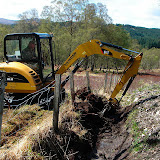 |
| Ditches and flowers |
We went to the Wood last weekend, and were looking for signs of advancing spring. Perthshire was lush and as green as Fife. From Laggan, along to Spean Bridge, the green was not as bright, probably because of the altitude. At the Wood, things were still looking a little wintry, as there is a fair amount of dead bracken and molinia straw and the bog myrtle is still brown, but it was better than the upper parts of the A9 and the Spean Bridge road. The birches were green, though their leaves were still very small; the stubby grass was nice and bright and coming on well, and even the new molinia leaves were pushing up through the old straw. Some of the new banks and barrows around the house were beginning to green up in clumps.
Roy hauled more logs out of the bog, and then got usefully side-tracked into digging out part of the Allt na Minion. I went to look for flowers over by the west burn and in the wood. No chickweed wintergreen or orchids yet; but there are a few violets, plenty of bluebell leaves, lots of anemones, mostly white but some pink, and some bright pink self-heal. I saw one milkweed in the hither side of the bog, and one bluebell in the wood near the hazel. There are lots of tiny new birches and rowans which it would be nice to save from the deer.
The pond developing itself on part of the route of the Klarg pipe is quite seriously deep. I have decided to put a thoroughly alien gunnera there with yellow wild irises, skunk cabbage (which I saw growing wild near Seattle) and candelabra primulas. We wonder if there may actually be a spring there, supplying that persistent wetness. It may have been disturbed when rocks were dug up as the pipe was laid.
On Sunday morning, quite out of the blue, Donald Cameron arrived, along with Fred from Inchlaggan, with the digger. As I was writing this, he was working down the ditch beside the middle fence, hauling out great slabs of peat and vegetation, laying them neatly in the bog, bashing them down slightly to lay them flat. The idea is to drain the east side of the bog below the house into the Allt na Minion, and then to improve the course of that burn. The machine is too big to do a drain for the bit that I fell in up to the top of my boots in the snow; but Roy will do that with a spade.
Monday, April 20, 2009
Daffodils
Has there been a revolution in the daffodil world?
We have become particularly interested in them, as we have been told that they are vegetables of which the deer not bites. (Quotation, sort of; look it up.) But when I went to the Peter Nyssen website I was surprised and perturbed to discover that they do not sell bulbs for autumn planting. Surely that used to be what one did? Have I read the information wrongly? If it is true, we have missed a whole season. Grinding of teeth, flashing of eyes, general appearance of samurai in frightening 19th century Japanese print. Ah - no. Thank you, Janet. I have misread it. But now I am perturbed because Nyssens don't have the exact daffodils I want. So there may be some transplanting of the ones we have in St Andrews.
When we manage to get some, I rather favour the wild sorts, and also jonquils, which we have flowering at St Andrews now. They smell gorgeous.
I am off to check whether there are other plants disliked by deer. I think there is a list of reasonably deer proof plants in the Glendoick book.
We have become particularly interested in them, as we have been told that they are vegetables of which the deer not bites. (Quotation, sort of; look it up.) But when I went to the Peter Nyssen website I was surprised and perturbed to discover that they do not sell bulbs for autumn planting. Surely that used to be what one did? Have I read the information wrongly? If it is true, we have missed a whole season. Grinding of teeth, flashing of eyes, general appearance of samurai in frightening 19th century Japanese print. Ah - no. Thank you, Janet. I have misread it. But now I am perturbed because Nyssens don't have the exact daffodils I want. So there may be some transplanting of the ones we have in St Andrews.
When we manage to get some, I rather favour the wild sorts, and also jonquils, which we have flowering at St Andrews now. They smell gorgeous.
I am off to check whether there are other plants disliked by deer. I think there is a list of reasonably deer proof plants in the Glendoick book.
Sunday, March 15, 2009
Walking in the Wood
Some people believe that when we live at the Wood our brains will atrophy and we will have nothing to do except sit around vacuously staring at the view. In fact, there are plenty of things to do, both intellectual and physical.
The physical things are fairly easy to list: collecting wood; sawing logs; ditching; walking around diligently exercising heart and muscle, which is what I did yesterday (pictures below). Today, we opened our pores for an hour and a half, throwing and dragging logs and branches from just up the hill to the wood pile. This has the satisfying effect of tidying the landscape as well as supplying fuel.
Indoors, I knit (pictures below of some of the twenty pairs of socks I have knitted this year – not all at the Wood) and do tapestry. Well, all of that is fairly mindless, though it leaves time to think other thoughts, some of which involve planning physical things: the location of more ditches; the delineation of paths (not actually making them, but finding ways of indicating preferred routes, such as by cutting the bracken, or identifying the convenient places to sit, which form markers along the way); where to place trees and other plants.
My walk yesterday was what I now regard as my favourite short circuit round the upper and middle part of the wood. It takes a fairly direct route to the eastern burn, and then along a prominent ridge parallel to the burn and overlooking it. There is another oak tree on this ridge, and hazels below it beside the burn, where there is a space between the bottom of the ridge and the burn itself which I am sure the Victorians would have turned into a lovely path, with interesting planting. There are plenty of knolls with boulders to sit on, and plenty of places demanding interesting specimens of tree or rhododendron. The ridges of moraine which run down the slope at intervals (usually with boggy bits between them) make for a great variety of views and visual possibilities.
Which leads us on to fencing, when we can afford it.
Ditching also came to the fore this weekend, as Donald Cameron, the ghillie from Kinlochhourn, came to talk about putting his machines to our rather silted up ditch, and to making new drainage in our wasteland, where I disappeared to the tops of my boots a few weekends ago, and had to be rescued by Livy It is always interesting talking to him.
And then the intellectual things. Why should we do less than we do at present? We don’t go to the theatre or concerts much – I don’t know why. We read, we write, we listen to music. Roy reminds me that when the Ellice family had Quoich Lodge (this was in the early years of the last century) they made it a centre of intellectual and cultural life, visited there by artists, writers, statesmen and the lions of their time. There’s a project for us.
The physical things are fairly easy to list: collecting wood; sawing logs; ditching; walking around diligently exercising heart and muscle, which is what I did yesterday (pictures below). Today, we opened our pores for an hour and a half, throwing and dragging logs and branches from just up the hill to the wood pile. This has the satisfying effect of tidying the landscape as well as supplying fuel.
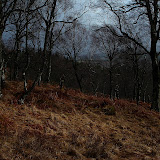 |
| Walking in the wood |
 |
| Socks |
My walk yesterday was what I now regard as my favourite short circuit round the upper and middle part of the wood. It takes a fairly direct route to the eastern burn, and then along a prominent ridge parallel to the burn and overlooking it. There is another oak tree on this ridge, and hazels below it beside the burn, where there is a space between the bottom of the ridge and the burn itself which I am sure the Victorians would have turned into a lovely path, with interesting planting. There are plenty of knolls with boulders to sit on, and plenty of places demanding interesting specimens of tree or rhododendron. The ridges of moraine which run down the slope at intervals (usually with boggy bits between them) make for a great variety of views and visual possibilities.
Which leads us on to fencing, when we can afford it.
Ditching also came to the fore this weekend, as Donald Cameron, the ghillie from Kinlochhourn, came to talk about putting his machines to our rather silted up ditch, and to making new drainage in our wasteland, where I disappeared to the tops of my boots a few weekends ago, and had to be rescued by Livy It is always interesting talking to him.
And then the intellectual things. Why should we do less than we do at present? We don’t go to the theatre or concerts much – I don’t know why. We read, we write, we listen to music. Roy reminds me that when the Ellice family had Quoich Lodge (this was in the early years of the last century) they made it a centre of intellectual and cultural life, visited there by artists, writers, statesmen and the lions of their time. There’s a project for us.
Saturday, February 28, 2009
Things I Will Have To Put Up With
Not everything is perfect. There are bound to be compromises and oversights. So for the sake of completeness here are the things that are not quite right.
The stairs are rather steep. We have been spoiled by the luxurious ones at Park Street. Janet would say the ones at the Wood are very laid back.
The utility room is very small.
Perhaps more food storage space would have been a good idea: a proper larder.
The Nibe controls require a degree in heat engineering. So far, we find the heat difficult to control. This may be our fault but we think not. Still, Graham Moss the Nibe man is tremendously obliging.
There are skirting boards. Originally, I passionately wanted shadow line skirtings. (My devil master James has them in his house extension; why can't I have them?) Then Mary said skirtings are unnecessary; and I agreed. Now we have skirtings. I am not sure why. Oh well.
Three lights over the table is perhaps too many.
Roy would prefer a joy stick shower control. I am perfectly happy with the taps we have.
Roy wishes there was more light in the bathroom and the small bedroom and slightly less in the main bedroom. I rather like the cosy dim feel of the bathroom. I agree we could have done with one window rather than two in the main bedroom.
The replacement lavatory seats (see earlier top secret posting) are not quite the right shape. We are probably the only people who have noticed this.
We are not quite sure that we specified the right locations for the telephone sockets. There are three (or is it four?) and not one of them is in the main bedroom or the study.
There are some fascinating misplacements of light switches. But we are getting used to them.
The multitude of legs on the canopy is still a little disconcerting. It would have been nice to cantilever it; but that would have meant more steel in the main structure. It would have been nice to manage with fewer.
It is fiddly to open the casement windows fully. But perhaps this will deter all our burglars. It would have been nice if the full length windows would open wide, like doors.
Roy would have liked a wine cellar.
The grey of the doors is not quite the same grey as the blinds.
The deck is not big enough. And it doesn't drain properly. (We are well into crumples in rose leaves territory now.)
The stairs are rather steep. We have been spoiled by the luxurious ones at Park Street. Janet would say the ones at the Wood are very laid back.
The utility room is very small.
Perhaps more food storage space would have been a good idea: a proper larder.
The Nibe controls require a degree in heat engineering. So far, we find the heat difficult to control. This may be our fault but we think not. Still, Graham Moss the Nibe man is tremendously obliging.
There are skirting boards. Originally, I passionately wanted shadow line skirtings. (My devil master James has them in his house extension; why can't I have them?) Then Mary said skirtings are unnecessary; and I agreed. Now we have skirtings. I am not sure why. Oh well.
Three lights over the table is perhaps too many.
Roy would prefer a joy stick shower control. I am perfectly happy with the taps we have.
Roy wishes there was more light in the bathroom and the small bedroom and slightly less in the main bedroom. I rather like the cosy dim feel of the bathroom. I agree we could have done with one window rather than two in the main bedroom.
The replacement lavatory seats (see earlier top secret posting) are not quite the right shape. We are probably the only people who have noticed this.
We are not quite sure that we specified the right locations for the telephone sockets. There are three (or is it four?) and not one of them is in the main bedroom or the study.
There are some fascinating misplacements of light switches. But we are getting used to them.
The multitude of legs on the canopy is still a little disconcerting. It would have been nice to cantilever it; but that would have meant more steel in the main structure. It would have been nice to manage with fewer.
It is fiddly to open the casement windows fully. But perhaps this will deter all our burglars. It would have been nice if the full length windows would open wide, like doors.
Roy would have liked a wine cellar.
The grey of the doors is not quite the same grey as the blinds.
The deck is not big enough. And it doesn't drain properly. (We are well into crumples in rose leaves territory now.)
Wednesday, February 25, 2009
Things I like about the house
The observant will have noted, perhaps with faint regret, that I have not posted anything for some months. Now that the house is finished, this blog is beginning to show its redundancy, and banging on about how pretty the wood and the house are may seem boastful and rude. But there are a few concluding comments to make before deciding whether to keep this page alive for other purposes.
The house works very well. (Should I add “so far”? No.) It has few redundant spaces; pretty much all of it is useful, unlike, for example, the hall at Park Street, which as I have already bored some of you by pointing out, is a perfect example of the point Frank Lloyd Wright made about the immorality of certain sorts of house design: making a show for one’s public face whilst consigning the important parts of the house, such as the kitchen, to an actual or metaphorical basement. I am pleased to say that coming more or less straight into the kitchen is a very nice way to enter a house. The big landing is good, too, even though we have not furnished it yet, and so it is not really operating as it is intended to do. The only rooms we do not regularly use ourselves are the spare bedroom (for which guests may be grateful) and the study, the latter because it has no furniture yet. But when the weather gets warmer I mean to keep the study door and the spare bedroom door open, for the views.
The vistas are probably the best thing about the design. You can see all the way through each floor, into every room except the utility room, the study and the upstairs spare loo, when all the doors are open; and when the study door is open you get an immediate view through to the back (or front) of the house as you come in the front (or back) door.
You do hear quite a lot of what is going on in other parts; but when that is music from the sitting room that is rather a good thing (depending on the music). Also, as I type this at the table, I realise that it is convenient for someone quietly doing difficult sums to Mozart in the sitting room to be able to ask the person in the kitchen, without shouting, for a vital cup of coffee, please. Hang on whilst I deal with that.
One more thing about the layout: how like it is to some of the vicarages we have lived in - the study near the front door so that the parishioners can be ushered straight in to see the vicar, and the family's places further in.
Other things I like: the kitchen. Well, it is a stronger emotion than mere liking. The wood; the height of the bench tops; the storage drawers; the lighting; two sinks; the taps; an extractor fan (first time since Poffley End where we had an industrial strength one that blew both ways, because we thought the Aga would like it); the space. I would write an exclamation mark here, if I had not taken a vow against them. And having a separate utility room.
Continuing with the list of the things I like: the sitting room. This means its shelves, though there are not enough of them and the top shelf requires the reach of an ape and the legs of a giraffe; and its windows, though I am not sure if the ones for the piano are quite large enough. It is a good size, too, and our stuff looks nice in it.
More. (As Dornford Yates would say.) The bathroom, loos and shower: their oak shelves, the neat little taps, the monsoon force shower (a combination of water under pressure and a big shower head), the shower seat, cantilevered loos, elegant big tiles.
The oak floors upstairs and the tiled ones downstairs. Nice, plain, and (downstairs) WARM (unless Nibe is away for the time being).
No draughts. I really am tempted to write an exclamation mark here. Even without curtains, and when Nibe was sulking at New Year when the temperature never got above freezing and was mostly rather far below it, the house is not cold. Double glazing, Scandinavian windows and lots of insulation in the walls and roof do the trick.
I could go on, but I won’t. Do come and see for yourselves how it works.
Arty pictures
The house works very well. (Should I add “so far”? No.) It has few redundant spaces; pretty much all of it is useful, unlike, for example, the hall at Park Street, which as I have already bored some of you by pointing out, is a perfect example of the point Frank Lloyd Wright made about the immorality of certain sorts of house design: making a show for one’s public face whilst consigning the important parts of the house, such as the kitchen, to an actual or metaphorical basement. I am pleased to say that coming more or less straight into the kitchen is a very nice way to enter a house. The big landing is good, too, even though we have not furnished it yet, and so it is not really operating as it is intended to do. The only rooms we do not regularly use ourselves are the spare bedroom (for which guests may be grateful) and the study, the latter because it has no furniture yet. But when the weather gets warmer I mean to keep the study door and the spare bedroom door open, for the views.
The vistas are probably the best thing about the design. You can see all the way through each floor, into every room except the utility room, the study and the upstairs spare loo, when all the doors are open; and when the study door is open you get an immediate view through to the back (or front) of the house as you come in the front (or back) door.
You do hear quite a lot of what is going on in other parts; but when that is music from the sitting room that is rather a good thing (depending on the music). Also, as I type this at the table, I realise that it is convenient for someone quietly doing difficult sums to Mozart in the sitting room to be able to ask the person in the kitchen, without shouting, for a vital cup of coffee, please. Hang on whilst I deal with that.
One more thing about the layout: how like it is to some of the vicarages we have lived in - the study near the front door so that the parishioners can be ushered straight in to see the vicar, and the family's places further in.
Other things I like: the kitchen. Well, it is a stronger emotion than mere liking. The wood; the height of the bench tops; the storage drawers; the lighting; two sinks; the taps; an extractor fan (first time since Poffley End where we had an industrial strength one that blew both ways, because we thought the Aga would like it); the space. I would write an exclamation mark here, if I had not taken a vow against them. And having a separate utility room.
Continuing with the list of the things I like: the sitting room. This means its shelves, though there are not enough of them and the top shelf requires the reach of an ape and the legs of a giraffe; and its windows, though I am not sure if the ones for the piano are quite large enough. It is a good size, too, and our stuff looks nice in it.
More. (As Dornford Yates would say.) The bathroom, loos and shower: their oak shelves, the neat little taps, the monsoon force shower (a combination of water under pressure and a big shower head), the shower seat, cantilevered loos, elegant big tiles.
The oak floors upstairs and the tiled ones downstairs. Nice, plain, and (downstairs) WARM (unless Nibe is away for the time being).
No draughts. I really am tempted to write an exclamation mark here. Even without curtains, and when Nibe was sulking at New Year when the temperature never got above freezing and was mostly rather far below it, the house is not cold. Double glazing, Scandinavian windows and lots of insulation in the walls and roof do the trick.
I could go on, but I won’t. Do come and see for yourselves how it works.
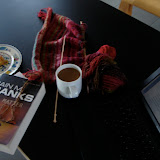 |
| What I did last weekend |
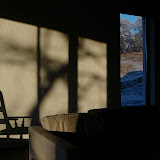 |
| 1 Jan 2009 |
Arty pictures
Sunday, February 08, 2009
EPW in snow
First: getting there
(travel reports of snow and disruption however the roads were fairly clear all the way to the top of the drive)
C&L spent the weekend (well Sat pm and Sun am) at the Wood in the snow.
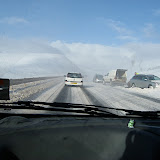 |
| Travel to EPW in the snow |
(travel reports of snow and disruption however the roads were fairly clear all the way to the top of the drive)
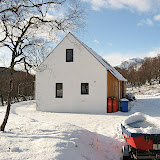 |
| EPW in Snow |
C&L spent the weekend (well Sat pm and Sun am) at the Wood in the snow.
Monday, January 05, 2009
The house is real...
The next house along the glen (Poulary) is available to let all year round. I've been googling it to see what it says - and noticed on this page that it is now described as being the SECOND house on the left after the cattle grid. Which means that EPW (the first on the left) is real, it exists and has had an impact on others!
Sunday, January 04, 2009
Saturday, January 03, 2009
Happy New Year
 |
| New Year at EPW |
The weather was absolutely beautiful. Mostly. The house wasn't exactly warm all over, as the underfloor heating seems to be under the impression that it's 41degreesC outside (hmm - try -10degC instead). However the wood burning stove was most impressive and the thick insulation all over seems to be working. I didn't even have a hot water bottle on the third night. We were quite good at keeping the doors closed and recycling heat back into the Nibe though (e.g. leave bath water to cool down before emptying the bath). And not opening the bathroom window to clear condensation (just let the Nibe extractors suck it out of the air instead).
Subscribe to:
Comments (Atom)

